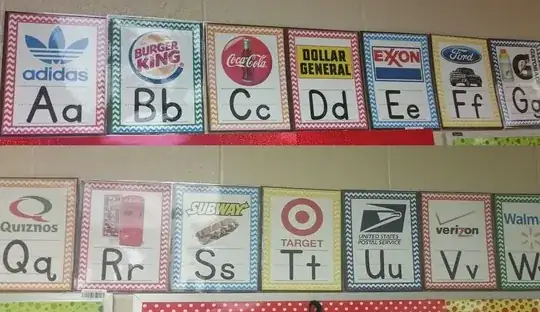YES
That seems not only very plausible. There is very little reason to doubt.
The actual, concrete picture may be just illustrative, manipulated, misattributed or the exact kindergarten picture untraceable on the net for authenticity. But why should it? The underlying concept and the actual use of this kind of tool in a preschool/kindergarten setting may only induce skepticism over whether it is a sign of disgusting consumerism or not. But there is not much reason to be skeptical whether an "American kindergarten teach[es] children the alphabet using corporate logos?" Because lots of them do. In various forms. Some forms use the exact same picture/letter combinations as displayed in question.
It's known for long that modern city reared children might have trouble telling apart an apple from a pear, but they are quite good at telling apart an Apple from a Samsung logo. This is now an accepted method for teaching visual and literary literacy: environmental print.
Another example can be found in the work of the American media theorist Carrie McLaren, who describes an exercise she undertook with high school students: “On the first day of class, I ask students to try and identify several plants and trees common in our Brooklyn neighborhood. They generally fail to name one. Then I show a slide of the alphabet comprised entirely from brand logos and they name almost all of them.”24 I have noticed a significant pattern emerging after showing this alphabet in several contexts, from K–8 schools to undergraduate and graduate classrooms, to academic conferences; while older academics can identify about 6–8 and university students, perhaps a dozen, younger children can generally name all of them — and usually with great enthusiasm. It is noteworthy that while cultural conservatives like E.D. Hirsch lament the decline of a common knowledge and call upon education to promote “cultural literacy,” it is apparent that youth today in fact already speak a common language. “What every American needs to know” is about brands and their meanings.
–– Trevor Norris (2007): "Consuming schooling: education as simulation", Philosophy of Education Yearbook, 162-171.
And recently
Back to school! Those first few days can always be challenging when you are trying to get students involved and building a community within the classroom. The brand alphabet activity isn’t a new one. There’s one floating around the internet from years ago that I used for years. But this year I wanted an updated version for students that had some more challenging logos included. I’m always surprised at the number of logos that are recognizable to students. I’m hoping that this version has a few that make students really have to think.
–– Niki: "Brand Alphabet Activity", Teach me Business, 2017
Apparently quite a few educators got inspired by this kind of research:
McDonald's, Toyota, Disney: Kids Recognize Brands, Corporate Logos
Study shows that preschoolers can recognize brand names.
Anna R. McAlister & T. Bettina Cornwell: "Children's Brand Symbolism Understanding: Links to Theory of Mind and Executive Functioning", Psychology and Marketing 27(3) · March 2010 DOI
Belk, R.W., Bahn, R.N. and Mayer, R.N. (1982), “Developmental recognition of consumption symbolism”, Journal of Consumer Research, Vol. 7, June, pp. 4-17.
At least it seems older than 2017:
Alphabet Sound Chart with Brand Logos (commented on 2014)
That is one of the structured teaching methods of environment based visual literacy among preschoolers. Prodcuts like this are available for download as printables for parents and teachers or ready made on internet market places. Whether this is primarily for teaching the logos themselves or the alphabet is quite irrelevant. This "late-stage capitalist" consumerism is in quite a few of the class rooms, now.
But for doubters: places like the Mott Community College Early Childhood Learning Center in Flint, Michigan, did offer such an alphabet activity for preschoolers, as evidenced by their "Newsletter December 2018" (PDF)
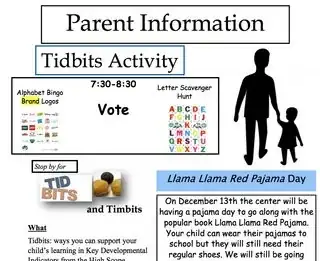
Or more explicitly:
Environmental print includes printed material that is commonly found throughout the community.
Some examples include: signs, logos, menus, and advertisements.
At Stepping Stone School, we use environmental print in our dramatic play and block centers to support interaction with print through child-directed play.
The benefit of using environmental print is that even very young children are able to make associations between a symbol (ie. The golden arches of McDonald’s) and a meaning (ie. Happy meals and playgrounds).
Making these associations are foundational to reading, therefore, we promote the use of environmental print in our classrooms on a regular basis.
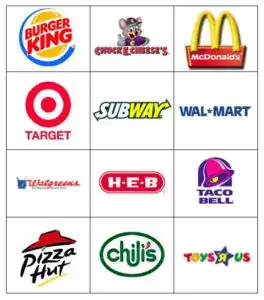
By incorporating opportunities for hearing stories on a daily basis, observing printed material, and interacting with it, the children at Stepping Stone School are prepared to embark on a journey of reading readiness which begins in our infant classrooms and continues to develop over the next several years as we prepare our children for Kindergarten.
–– "The Importance of Classic Literature",
Published on Monday, January 15th, 2018 Published by Stepping Stone School
.
We Can Read helps very beginning readers to see themselves as readers in the world. Utilizing visual orthography, students create pages filled with logos, brands and labels that they can read from their lives around them. This activity encourages even the most novice of readers to interact with print and helps provide motivation and promote confidence in beginning readers. In the Individual ABC Books activity, teachers use quality literature to model, provide inspiration to students, and connect an alphabetic principle to print awareness.
–– Kristina D. Q. Mathisen: "Best Practices In Reading Instruction For Emergent Readers Pre-K Through First Grade", Master of Arts Thesis in Education, Sacramento, 2014.
Early writing attempts can easily be promoted by deliberately stocking children’s play and learning areas with a combination of authentic environmental print and writing supplies along with other props. For example, a block center that contains street signs, “under construction” labels, and corporate logos such as those from restaurants and manufacturers encourages the use of environmental print when building. Coupling such signs with blank index cards, sticky notes, and markers promotes environmental printing as children label or write about their structures. 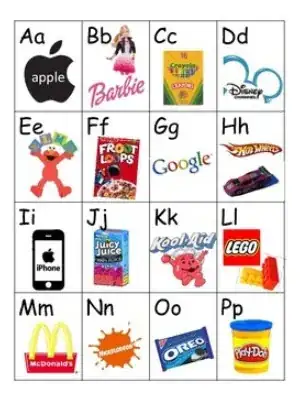
–– Michael Sandberg: "Shapes, Pictures and Colors: Environmental Print as a Teaching Tool", Data Vizualisation Blog, January 22, 2015. Sourcing Rebecca McMahon Giles & Karyn Wellhousen Tunks: "Children Write Their World: Environmental Print as a Teaching Tool", Dimensions of Early Childhood, Fall 2010, Volume 39, Number 3, PDF.
PreK-Pages: What is environmental print?
Vanessa, a Pre-K teacher with more than 20 years of classroom teaching experience. Here at Pre-K Pages, I'm committed to helping teachers just like you teach better, save time, and live more by providing you with everything you need to create a fun and engaging learning environment, lesson plans, and activities for your little learners. As an early childhood trainer, I have spoken to thousands of teachers in person at popular early childhood conferences such as Frog Street Splash, I Teach K! and NAEYC. I was honored to receive the 2012 CCAEYC Trainer of the Year Award. My work has been featured in Scholastic Teacher magazine and on popular websites like BuzzFeed.
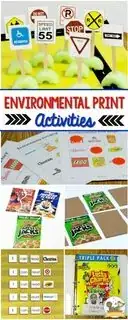
KindergartenChaos, 2018:
I taught 1/2 day Kindergarten for 2 years and have been teaching full-day Kindergarten for 5 years. I am in love with teaching kinder and hope you find something here on my blog that you can use to teach your students!
Environmental Print Alphabet:

From a journal that cites Cunningham, P. (1998): "Want to teach basic skills? Try brand-name phonics!", Instructor, 105 (5), 44-45. & Horner, S.L. (2005): "Categories of environmental print: All logos are not created equal", Early Childhood Education Journal, 33(2), 113-119. & Wepner, S. (1985): "Linking logos with print for beginning reading success", Reading Teacher, 38(7), 633-639.:
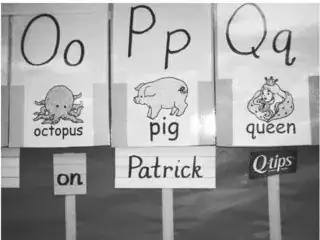
Photo 3: Environmental print enhances a traditional word wall. Digital photographs of familiar street signs, names of businesses, and billboards found in the community can also be displayed to stimulate children’s interest in the print around them and provide both inspiration for and models of writing.
–– Rebecca McMahon Giles and Karyn Wellhousen Tunks: "Children Write Their World: Environmental Print as a Teaching Tool", Dimensions of Early Childhood, Volume 38, Number 3, 2010. (PDF)

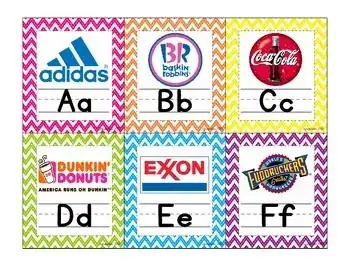
The exact layout for the claim in question is found on pinterest and sourced as from teacherspayteachers:
Product Description
I made these environmental print alphabet posters as a way for my students to associate brands, stores and other recognizable names with the letters of the alphabet. The template I used (blank frames and letters) was made by Missy Gibbs.
Note: I teach in Indianapolis, so some of these brands might be specific to our area :)
Sarah Wilson: "Environmental Print Classroom Alphabet", Subject
Balanced Literacy, Reading, Phonics
Grade Levels: PreK, Kindergarten, 1st, 2nd, 3rd
Resource Type
Fun Stuff, Word Walls, Bulletin Board Ideas
First comment is from 2017 by a teacher claiming to use this as well.
And as the original is available in readymade abd template-to-adapt Missy Gibbs version is offered as a 'freebie' (rated as 4 out of 4 stars and on sale since 2014?:
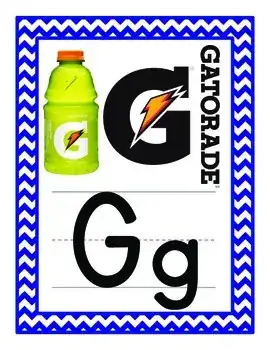
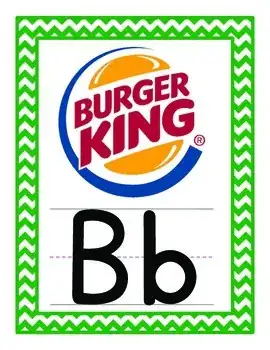

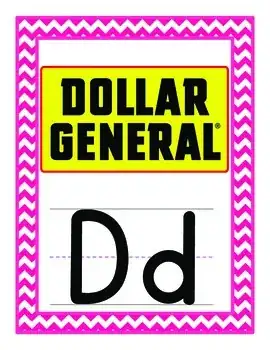
These three sets of environmental print alphabets most closely resembling the wall shown in the claim were downloaded from teacherspayteachers by 24436 'teachers' (logged in users of that site). The sets are also available elsewhere and can be printed multiple times and shared offline. How many versions actually ended up in preschool classrooms is an exercise left to the reader.
